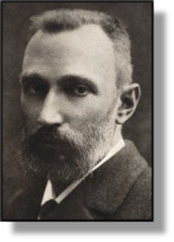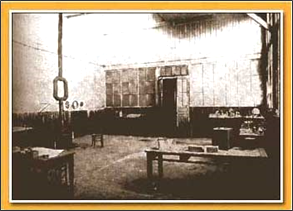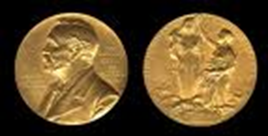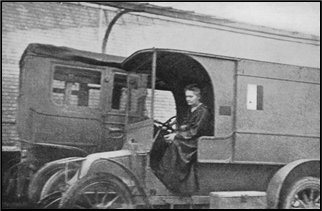


xxxxxIt was after the discovery of X-
MARIE CURIE 1867 -
PIERRE CURIE 1859 -
Acknowledgements
Marie: by the Parisian photographer Henri Manuel (1874-

 xxxxxIt was in 1898, that the husband and wife team Pierre and Marie Curie, -
xxxxxIt was in 1898, that the husband and wife team Pierre and Marie Curie, -
xxxxxMarie Curie, originally Maria Sklodowska, was born in Warsaw, then within the Russian Empire. Her father was a local teacher in mathematics and physics, and it was from him that she first acquired her interest in science. After completing her schooling, she worked as a private tutor and governess for a number of years before beginning her studies in physics and mathematics at the Sorbonne (the University of Paris) in 1891. By 1894 she had gained degrees in both subjects and, after a brief holiday in Warsaw, returned to make a study of the magnetic properties of steel. It was at this time that she met Pierre Curie, a young physicist who had already made a name for himself. Among other findings, he had established the phenomenon of piezoelectricity, created when pressure is exerted on certain crystals, and, during his study of the relationship between magnetism and heat, he had established the Curie point, the temperature above which ferromagnetic substances lose their magnetism.
 xxxxxThey married in 1895, and the following year, fascinated by the findings of Henri Becquerel, Marie decided to carry out research into these mysterious uranium radiations. At that time her husband was laboratory chief at the Paris Municipal School of Industrial Physics and Chemistry, and she was thus able to set up her laboratory in a draughty but disused storeroom on the premises. Using an electrometer specifically designed to measure a very low electric charge -
xxxxxThey married in 1895, and the following year, fascinated by the findings of Henri Becquerel, Marie decided to carry out research into these mysterious uranium radiations. At that time her husband was laboratory chief at the Paris Municipal School of Industrial Physics and Chemistry, and she was thus able to set up her laboratory in a draughty but disused storeroom on the premises. Using an electrometer specifically designed to measure a very low electric charge -
xxxxxSuch was the potential importance of this conclusion, that her husband then set aside his research on crystals and joined her in her research. Having removed the uranium from a quantity of pitchblende, they carried out a series of chemical treatments on the residue and in July and December of 1898 discovered two new radioactive elements. They named the first polonium (in honour of Marie’s homeland), and the second radium, after the Latin word for “ray”. In each case, the amount detected was miniscule but, as suspected, both elements were highly radioactive. Compared with uranium, polonium had a level of radioactivity 400 times higher, and radium 900 times higher.
 xxxxxMarie announced their findings in December, but the amount obtained of each element was so minute -
xxxxxMarie announced their findings in December, but the amount obtained of each element was so minute -

xxxxxMarie submitted her doctoral dissertation on her research in 1903 and, in the same year, she and her husband, together with the French physicist Henri Becquerel, were jointly awarded the Nobel Prize for Physics for the discovery of radioactivity. The following year Pierre was appointed Professor of Physics at the Sorbonne, with Marie as his first assistant. The work they had done, and the discoveries they had made were at last recognised, and the money from their prizes helped to improve their standard of living, but in 1906 tragedy struck. While crossing a Paris street Pierre was run down and killed by a horse-
 xxxxxWhen the First World War broke out in 1914, together with her daughter Irène, she turned all her efforts to the development of radiography in medicine. As head of the Radiological Service within the International Red Cross, she held courses to teach doctors and medical orderlies how to use the new technique, established some 200 radiology units, and equipped a number of vehicles with X-
xxxxxWhen the First World War broke out in 1914, together with her daughter Irène, she turned all her efforts to the development of radiography in medicine. As head of the Radiological Service within the International Red Cross, she held courses to teach doctors and medical orderlies how to use the new technique, established some 200 radiology units, and equipped a number of vehicles with X-
xxxxxMarie Curie’s health began to deteriorate in the late 1920s, and she died in Haute Savoie from leukaemia in July 1934, a disease caused by prolonged exposure to the radioactive materials which she had studied so diligently over so many years. Radium brought her both fame and death. Unaware of the dangers associated with radioactivity, neither she nor her husband had taken any precautions during their research. The extent of her exposure to these harmful rays is borne out by the fact that, even today, her notebooks are too contaminated to handle.
xxxxxIncidentally, in 1905, the year before his tragic death, Pierre Curie was named a member of the French Academy of Science. However, despite his wife’s outstanding scientific achievements, in 1911, the year she was awarded the Nobel Prize for Chemistry, the Academy continued to show its prejudice against women. She failed by two votes to be named a member. Edouard Branly, the French physicist who had assisted Marconi to develop wireless telegraphy, was elected in her place. ……

xxxxx…… After her funeral Marie Curie was interred alongside her husband at the cemetery at Sceaux, in south Paris. In 1995, however, both their remains were transferred to the Pantheon in the heart of the city (illustrated), a mausoleum reserved for the remains of distinguished citizens of France. She was the first and, to date, the only woman to be honoured in this way. The Curie Museum is situated a short distance from the “miserable old shed” where she and her husband worked so hard, and the unit by which radioactivity is measured is called the curie after her. ……
xxxxx…… The Curies had two daughters, both of whom had distinguished careers. In 1935 Irène, a doctor in science, was awarded the Nobel Prize in Chemistry, together with her husband Frédéric Joliot, for the discovery of artificial radioactivity. Eve gained degrees in science and philosophy, but then turned to journalism and writing. Her most celebrated work was the brilliant biography of her mother, published in 1937. ……
 xxxxxFollowingxthe work achieved by the Curies, research into radioactivity was continued by the likes of the New Zealand scientist Ernest Rutherford (1871-
xxxxxFollowingxthe work achieved by the Curies, research into radioactivity was continued by the likes of the New Zealand scientist Ernest Rutherford (1871- a” ray. Then in 1902, Rutherford and Soddy, studying the properties of thorium at McGill University in Montreal, discovered that this chemical element decayed at a fixed rate and, over time, changed into a different element by a process that came to be known as atomic transmutation. It was such findings, refined and expanded over the years, that was to create a new field of physics, a branch of science which, for mankind, had the potential of being both very beneficial and enormously destructive.
a” ray. Then in 1902, Rutherford and Soddy, studying the properties of thorium at McGill University in Montreal, discovered that this chemical element decayed at a fixed rate and, over time, changed into a different element by a process that came to be known as atomic transmutation. It was such findings, refined and expanded over the years, that was to create a new field of physics, a branch of science which, for mankind, had the potential of being both very beneficial and enormously destructive.
Vc-
Including:
William Ramsay

xxxxxIt was also in the closing years of the 19th century that advances were made in the discovery of the so-
 xxxxxIt was also at this time, the closing years of the 19th century, that advances were made in the discovery of the so-
xxxxxIt was also at this time, the closing years of the 19th century, that advances were made in the discovery of the so-

xxxxxInx1894, working with the English physicist Lord Rayleigh (1842-
xxxxxIncidentally, Lord Rayleigh, born John William Strutt, wrote a two-


